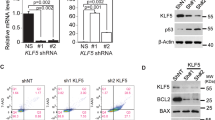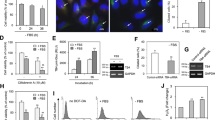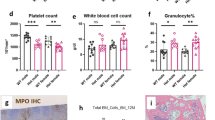Abstract
Ectopic expression of the normal murine receptor tyrosine kinase, c-Kit, in NIH3T3 cells induced many phenotypic changes characteristic of transformation including anchorage-independent growth, focus formation and tumorigenicity in nude mice. Although transformation was largely dependent on the presence of recombinant murine Steel Factor (SLF), the ligand to the c-Kit receptor, anchorage independent growth did occur at a low frequency in the absence of added factor, and this could not be inhibited by neutralising antibodies or by SLF anti-sense mRNA. Clones from factor-independent colonies in semi-solid agar displayed a narrow range of c-Kit surface protein levels (4.3 – 6.4×104 receptors/cell) which was relatively high compared with the pool from which they were derived. Analysis of a larger series of random clones derived from adherent cultures expressing different levels of c-Kit demonstrated a positive correlation between SLF-dependent, anchorage-independent growth and c-Kit protein and mRNA expression levels (respectively, RS=0.58, P<0.01; and RS=0.53, P<0.01) with consistent colony formation observed with clones having >2.5×104 receptors/cell. Interestingly, two of the three clones expressing the highest levels of c-Kit protein and mRNA produced few or no colonies in the presence or absence of SLF. Sequential over-expression of human c-KIT in NIH3T3 cells using a dihydrofolate reductase (DHFR)-encoding vector and gene co-amplification through methotrexate selection, which resulted in pools expressing up to 1.5×105 receptors/cell, confirmed that high receptor densities resulted in a decrease in colony numbers. Thus, analysis of clonal and selected populations has indicated that an optimal level of c-Kit is required for transformation of NIH3T3 cells in the presence of SLF, and that some ligand-independent transformation occurs.
This is a preview of subscription content, access via your institution
Access options
Subscribe to this journal
Receive 50 print issues and online access
$259.00 per year
only $5.18 per issue
Buy this article
- Purchase on SpringerLink
- Instant access to full article PDF
Prices may be subject to local taxes which are calculated during checkout
Similar content being viewed by others

Author information
Authors and Affiliations
Rights and permissions
About this article
Cite this article
Caruana, G., Cambareri, A., Gonda, T. et al. Transformation of NIH3T3 fibroblasts by the c-Kit receptor tyrosine kinase: effect of receptor density and ligand-requirement. Oncogene 16, 179–190 (1998). https://doi.org/10.1038/sj.onc.1201494
Received:
Revised:
Accepted:
Published:
Issue date:
DOI: https://doi.org/10.1038/sj.onc.1201494
Keywords
This article is cited by
-
‘Youthful’ phenotype of c-Kit+ cardiac fibroblasts
Cellular and Molecular Life Sciences (2022)
-
Overexpression of KIT in chromophobe renal cell carcinoma
Oncogene (2003)
-
STAT3 activation is required for Asp816 mutant c-Kit induced tumorigenicity
Oncogene (2001)
-
Isoforms of c-KIT differ in activation of signalling pathways and transformation of NIH3T3 fibroblasts
Oncogene (1999)


